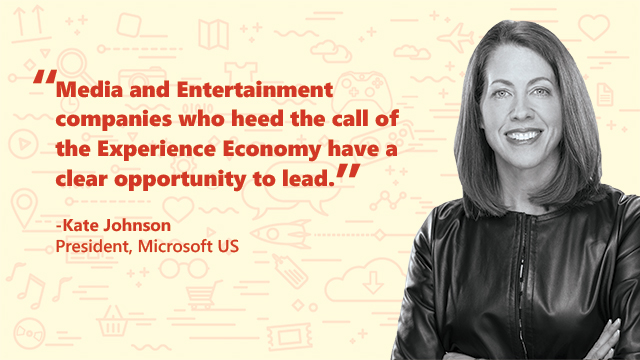
The future of media and entertainment in the experience economy
No industry will be left untouched by this crazy digital era. I’ve been on a learning journey for the past few months, seeing core business challenges in several different markets. One that really jumps out: media and entertainment. From connected TVs to mobile and on-demand media, content creators continue to increase their output as audiences look for more personalized experiences. The companies that respond to these consumer experience demands will be rewarded with brand loyalty and a rich mine of data that will provide deep audience insights. Three critical trends have emerged in this Experience Economy, which will directly impact the future of the industry.
Trend #1: An explosion of content
Content is everywhere, on every device, available 24/7. This has changed the relationship between traditional media companies and their audiences and created a wave of direct-to-consumer (D2C) services. At the same time, consumer expectation has forced media companies to re-imagine content creation and content management. Historically, studios and broadcasters have delivered programming to TVs and theaters on their own terms (resulting in “appointment viewing” for audiences) and monetized that programming through advertising, ticket sales, and home entertainment revenues. Programming and monetization models are being disrupted with the changing consumer consumption demands and behavior.
What does this mean for traditional media and entertainment companies? Companies are quickly announcing plans to launch their own D2C streaming services to take advantage of “cable cord-cutting;” consumers, in turn, are expecting more from their content providers. Audiences are demanding more personalized content delivery, screens free from clutter and unwanted messaging, and increased control of their viewing experiences. Media companies are moving their content creation and content management to the cloud to quickly react to market dynamics and consumer demand.
Trend #2: Radically changing advertising dynamics
The explosion of digital content delivered via paid streaming services—and consumers’ general affinity for digital programming—has caused a multi-year decline in TV ad spending. Digital ad spending is increasing in parallel and is likely to surpass traditional ad spending for the first time in 2019.
What does this mean for traditional media and entertainment companies? Media companies have been optimizing their advertising platforms and operations by doubling down on audience intelligence, analytics, and data management platforms to manage more robust segments and profiles. This automation has led to a better understanding of cross-channel audiences, better ad targeting, and more relevant and personalized ad experiences. Consumers have signaled that they are willing to view ad-supported content in linear channels, provided the messaging is relevant, engaging, and non-intrusive. Many media companies are re-defining their programming paradigm to include second-screen watch experiences and advertiser-supported “pods” to help drive the purchase of products directly in-show.
Trend #3: Rethinking trust in a new era of data privacy
Ad-targeting is good for the advertiser, but it must be good for the consumer too. Trust in media – particularly news media – is at an all-time low, and repeated breaches of security and privacy across social media networks and advertising giants have made customers leery of how much they are willing to share. Yet data is the foundational currency of advertising, personalized experiences, and brand loyalty; it drives most content decisions across the industry’s value chain.
What does this mean for traditional media and entertainment companies? In the personalized experience scenario, data provides the ability to deliver the most relevant content possible. This leads to deeper engagement, longer viewing time and improved brand loyalty. Keeping this data secure and in accordance with GDPR standards is mission-critical when it comes to establishing and maintaining consumer trust.
As the Experience Economy continues to drive the media and entertainment landscape, the appetite for more and increasingly diverse content will not abate. The challenge is getting it to the right audience, at the right time, on the right device, with the right monetization model. Microsoft deeply understands these market trends and is the only neutral, secure, and globally scalable platform cloud that does not compete with traditional media companies.
I’m looking forward to supporting our media and entertainment customers and digital ecosystem with technology and solutions that enable them to run, grow, and expand their rapidly transforming businesses!
Let’s continue the conversation, follow:
@MSFT_Business on Twitter
Microsoft in Business on Facebook
Kate Johnson on LinkedIn




